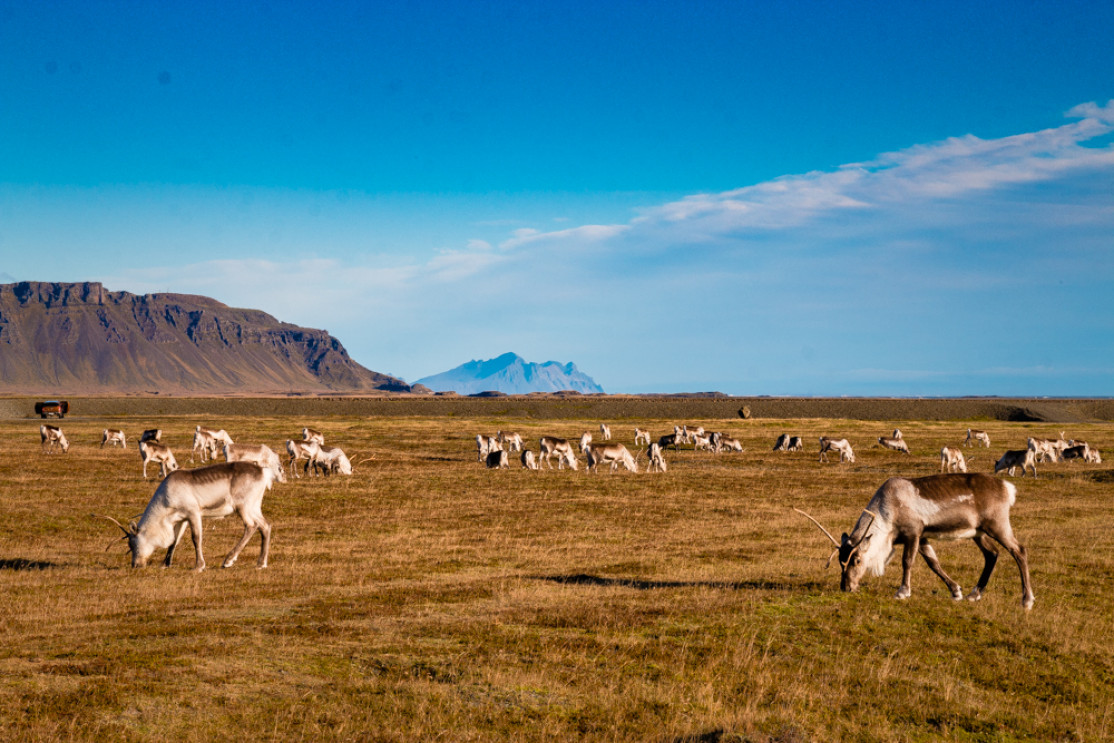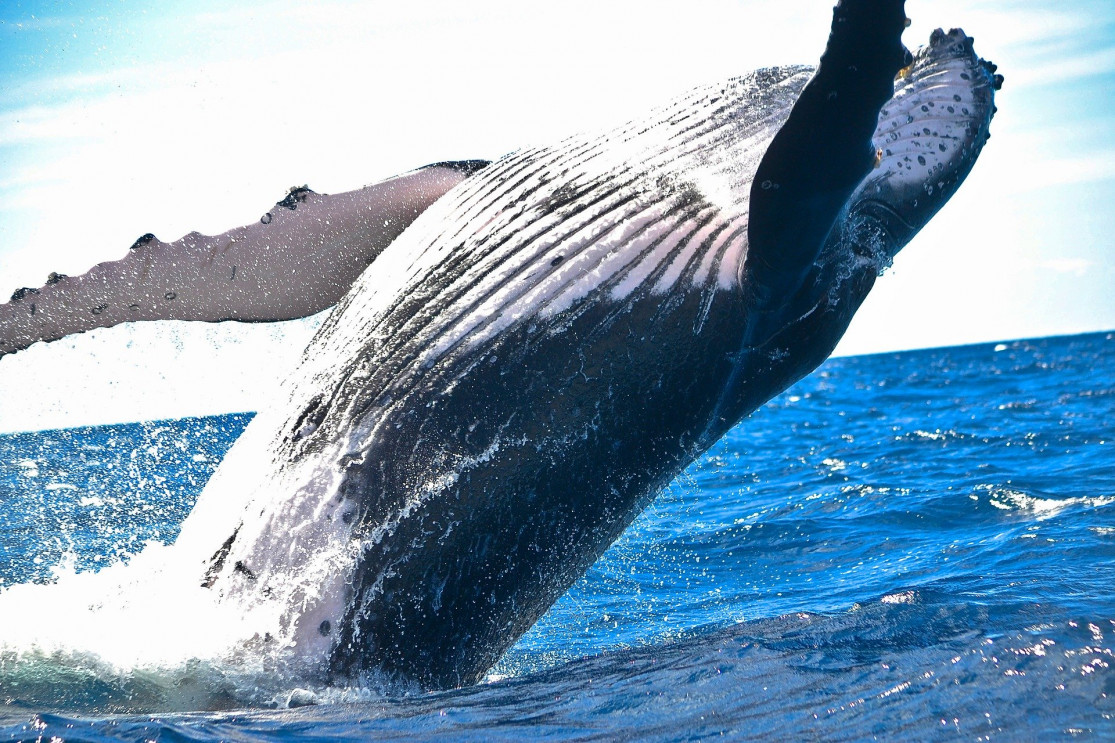Iceland's Wildlife
Iceland's unique geography and geology do not make this island particularly hospitable to terrestrial mammals, in fact quite the opposite. As a result, animals in Iceland are concentrated in coastal regions, and mostly aquatic or winged creatures.
In this article we will cover terrestrial and marine wildlife in Iceland:
For additional information about Iceland's birdlife, check out our dedicated article:
Terrestrial wildlife
The polar fox
The Arctic or polar fox is technically the only “native” land mammal in Iceland, which settled on the island back when it was connected to the mainland by the ice sheet. There are two types polar foxes in Iceland named after their two distinct coat colors: the white and the “blue” polar fox which is the most common here.
This famous fur coat changes with the seasons, brightening with winter to better blend in with nature. These are small animals averaging 30 cm tall at the withers for 2 to 5 kilos in weight, that is to say smaller than the foxes found in other Arctic regions.
Very opportunistic, the polar fox feeds on just about anything it can find: from prey it catches (birds, field mice, etc.) to the carcasses of marine animals or other waste that wash up on beaches.
Other terrestrial animals in Iceland exist but these are not native, having been introduced from outside the island, voluntarily or not, most often by humans.
Gray field mice and minks
The rodents live mainly in urban areas, where there is heat and food, but the field mouse is the only species that lives throughout the island. Then there is a population of mink which were imported and raised locally for the fur trade, but a number of them escaped the farm and returned to the wild.
Despite intensive hunting they are still found in significant numbers throughout Iceland. These animals are particularly fond of eggs and the young chicks of all sorts of birds, especially puffins and eiders, but they also occasionally eat small fish and other rodents.

The reindeer
Reindeer were imported from Lapland in the 18th century in a period of serious famine raging in the country. They attempted to breed the hardy species locally, but this was unsuccessful and the reindeer returned to the wild.
Their population exploded in the decades that followed, and began stripping pastures intended for sheep and causing hardship on the locals. In response they were hunted almost to extinction, until reason prevailed and they became a protected species. Today about 3000 individuals populate the island, mainly in the East.
Additional information:
The Icelandic horse
This is an animal that is often encountered along the roads, their manes ruffled by the wind. The Icelandic horse is a small breed of horse, averaging 1.45 meters at the withers such that it looks almost like a pony. This breed has remained pure since these horses were introduced to the country by the Vikings 11 centuries ago.

These ponies are built like tanks, surviving in the harshest weather conditions, loyal and affectionate without needing much food. The Icelandic horse is not only popular but vital to many Icelanders living in hostile environments.
One of its main characteristics is its unique gait, of which it has 4 rather than the usual 3: the walk, the trot, the canter/gallop, and the “tölt”. Tölt (pronounced Teult) is a very smooth 4-beat lateral gait that is comfortable at all speeds. The particularity of this pace is that the horse always has at least one foot on the ground. Some breeds even have a 5th gait, the flying pace, which is a sight to behold.
More information can be found at:
Icelandic sheep
One thing is certain, you can't talk about Iceland without mentioning sheep! These are the ones you'll see the most as they are countless and farmed in every corner of Iceland. They were imported by the Vikings for their wool, milk, and meat. Any visit to Iceland will involve sheep in the background, sheep in the foreground, and hundreds of sheep along the side of and sometimes right in the middle of the road you are driving on...
Polar bears
These are occasional visitors, stopping by only when an iceberg takes them to Iceland. These polar bears often have to be euthanized whenever they make an appearance in the Icelandic landscape, unfortunately, as they are considered too dangerous to repatriate.
Coastal wildlife

Pinnipeds is the order of marine mammals that covers seals and walruses, and this is one of the most represented on Iceland's coasts as these are breeding grounds. This adds up to about 50,000 seals, divided into 7 species, that frequent Icelandic waters.
Greenland seals, bearded seals, hooded seals and marbled seals are those found in northern waters, and also the rarest. Ringed seals, the smallest of the bunch at 90 kg, also migrate from Greenland to the Northwestern fjords in winter. But the two most common seal species in Iceland are the gray seal and especially the harbor seal.
The gray seal weighs 120 to 190 kg and there are about 3,000 individuals on the Icelandic coast. The harbor seal, on the other hand, weighs 100 to 150 kg and there are about 30,000 individuals on the island. Both species can be observed throughout the year.
For seal-watching, there are places where seal colonies return regularly, so it's actually quite easy to find them and you can get quite close (with great discretion to avoid scaring them) and snap a few photographs. Grey seals prefer the rocky coasts of the south (Reykjanes Peninsula) while harbor seals are generally seen on sandy beaches.
The Vatnsnes peninsula in the North is known to foster large seal colonies, specifically in Hindisvìk in the far north, where they are very easy to approach. On this same peninsula you will find the “seal house”, located in Hvammstangi, where you can learn all about the main observation sites.
The fjords in the northwest are home to most of the rarest seals. Walruses from Greenland have even been observed there in winter. It is not unusual to see a seal basking in the bottom of a fjord in Isafjarðjup Bay for example. The beautiful sandy beaches of Rauðasandur are also a place where you will have a good chance of spotting marine seals doing their gymnastics, shaped like a half moon on the beach.
In the east, a colony of marine calf seals can also be observed in the Jökulsá á Dal estuary near Heraðsflòi Bay, in sandy areas. Further south, Höfn and its rocky shores are famous for their gray seals and seals are also regularly photographed in Jökulsarlon, playing between icebergs.
Finally, in the West, on the Snaefellsnes peninsula, behind the Ytri Tunga farm, a seal colony has taken up residence for years and can be very easily approached a few meters away if we are forgotten or at least the seals get used to our presence.
Maritime wildlife

Icelandic waters, like the Arctic seas generally, are particularly rich in plankton and krill, which is exactly the type of environment that whales love. Around fifteen species of cetaceans can be found off the shores of Iceland, including dolphin and whale species. There are two types of whales, baleen whales and toothed whales, which separates those that are microphages from those that have teeth to chew larger fish.
Baleen whales use a "baleen" made of keratin to filter large quantities of water rich with krill, plankton, small fish, and shrimp. The most common species off the coast of Iceland are fin whales (20-25m), sei whales (15m), and minke whales (7-10m). Other cetaceans that you can find here include white-billed dolphins, mainly along the south coast, especially in spring and late summer.
A whale that definitely has teeth in these Icelandic waters is the killer whale. Males can reach a length of 9 meters and weigh up to 9 tons, with a very large dorsal fin, and these creatures are easily recognized by their characteristic black back, white belly, and white spots behind and above the eye. These are considered super-predators, as they hunt in packs and feed mainly on fish and other marine mammals (sea lions, seals, whales, etc.) but never attack humans. This particular species was made famous on the big screen with the movie “Free Willy”. The killer whale featured in this movie, Keiko, was captured in Iceland in 1979, where he was released 20 years later.
Another famous type of whale found here is the sperm whale, as in the mythical novel Moby Dick by Herman Melville. The sperm whale is distinguished by the shape of its head, almost rectangular, and is the marine mammal with the largest brain. Adult males can measure up to 18 meters and weigh up to 50 tons. This toothed whale eats a range of fish and sea creatures including giant squid, octopus, seal, but also shark. It is found both in the Arctic Ocean and in warmer waters where it can find food.
Whales represent a serious economic asset for Iceland. In fact, the country resumed whaling for scientific purposes with a quota of 200 minke whales in 2003, and in October 2006 commercial whaling with a fishing quota set at 9 fin whales and 30 minke whales per year.
Of course, any endangered species will be off limits to Iceland's fishermen, but the whole industry remains the subject of intense debate. Especially since parallel activities such as whale watching, which consists of observing whales evolving in their natural habitat, seem much more lucrative and represent the real asset.
See also:

